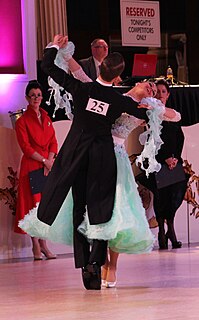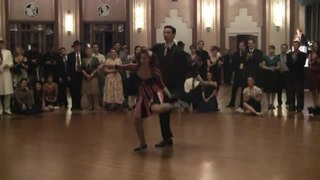Related Research Articles

Ballroom dance is a set of partner dances, which are enjoyed both socially and competitively around the world, mostly because of its performance and entertainment aspects. Ballroom dancing is also widely enjoyed on stage, film, and television.
East Coast Swing (ECS) is a form of social partner dance. It belongs to the group of swing dances. It is danced under fast swing music, including rock and roll and boogie-woogie.
West Coast Swing is a partner dance with roots in the Lindy Hop. It is characterized by an elastic look that results from its extension-compression technique of partner connection and is danced primarily in a slotted area on the dance floor. The dance allows for both partners to improvise steps while dancing together, putting West Coast Swing in a short list of dances that emphasize improvisation.
Dance moves or dance steps are usually isolated, defined, and organized so that beginning dancers can learn and use them independently of each other. However, more complex movements are influenced by musicality and lyrical relevance to express emotions or refer to a message. Dance moves tend to emphasize the concepts of lead and follow and connection.

Swing dance is a group of social dances that developed with the swing style of jazz music in the 1920s–1940s, with the origins of each dance predating the popular "swing era". Hundreds of styles of swing dancing were developed; those that have survived beyond that era include Lindy Hop, Balboa, Collegiate Shag, and Charleston. Today, the best-known of these dances is the Lindy Hop, which originated in Harlem in the early 1930s. While the majority of swing dances began in African American communities as vernacular African American dances, some influenced swing-era dances, like Balboa, developed outside of these communities.

Salsa is a Latin dance associated with the music genre of the same name which was first popularized in the United States in the 1960s in New York City. Salsa is an amalgamation of Cuban dances such mambo, pachanga, and rumba as well as American dances such as swing and tap.
Shag, or Shagged, or Shagger, or Shagging, or Shags may refer to:
The Big Apple is both a partner dance and a circle dance that originated in the Afro-American community of the United States in the beginning of the 20th century.

The quickstep is a light-hearted dance of the standard ballroom dances. The movement of the dance is fast and powerfully flowing and sprinkled with syncopations. The upbeat melodies that quickstep is danced to make it suitable for both formal and informal events. Quickstep was developed in the 1927s in New York City and was first danced by Black Americans. Its origins are in combination of slow foxtrot combined with the Charleston, a dance which was one of the precursors to what today is called swing dancing.
The hustle is a catchall name for some disco dances which were extremely popular in the 1970s. Today it mostly refers to the unique partner dance done in ballrooms and nightclubs to disco music. It has some features in common with mambo, salsa and swing dance. Its basic steps are somewhat similar to the discofox, which emerged at about the same time and is more familiar in various European countries. In the 1970s there was also a line dance called the hustle. Modern partner hustle is sometimes referred to as New York hustle, however, its original name is the Latin hustle. People still do this dance around the world today.
Triple step is a generic term for dance step patterns that describes three steps done on two main beats of music. Usually they are two quick steps and one slow one, i.e., often they are counted as "quick-quick-slow", "one-and-two", "three-and-four", etc.

The cha-cha-cha, is a dance of Cuban origin. It is danced to the music of the same name introduced by Cuban composer and violinist Enrique Jorrin in the early 1950s. This rhythm was developed from the danzón-mambo. The name of the dance is an onomatopoeia derived from the shuffling sound of the dancers' feet when they dance two consecutive quick steps that characterize the dance.
Single Swing is a fast dance rhythm in the larger swing family of dances.
Beach music, also known as Carolina beach music, and to a lesser extent, Beach pop, is a regional genre of music in the United States which developed from rock/R&B and pop music of the 1950s and 1960s. Beach music is most closely associated with the style of swing dance known as the shag, or the Carolina shag, which is also the official state dance of both North Carolina and South Carolina. Recordings with a 4/4 "blues shuffle" rhythmic structure and moderate-to-fast tempo are the most popular music for the shag, and the vast majority of the music in this genre fits that description.
The country/western two-step, often called the "Texas two-step" or simply the "two-step," is a country/western dance usually danced to country music in common time. "Traditional [Texas] two-step developed, my theory goes, because it is suited to fiddle and guitar music played two-four time with a firm beat [found in country music]. One-two, one-two, slide-shuffle." The two-step is related to the polka, the Texas waltz, and the jitterbug.
The Texas two-step is the same step known to ballroom dancers as the international fox-trot. Except for the one-step, which is just that, most Texas dances are variations of a two-step, also called a half-step, which is simply a step-close-step. The Texas two-step is generally done with two long steps and a step-close-step to two-four time. Speeded up, it's a shuffle or double shuffle, but still a two-step.
Rock step may refer to one of several similar dance moves. The name refers to the rocking action during the move: the weight is transferred from one foot to another and then back. It is used in a number of dances, such as East Coast Swing, Zydeco, Lindy Hop, Tango.
St. Louis shag is a swing dance that evolved from the Lindy Hop, Collegiate Shag and Charleston. It is a fast, closed position dance that is usually done to stomp, jump, and boogie-woogie music.
Chicago-Style Stepping is an urban dance that originated in Chicago and continues to evolve nationwide and overseas, while defining its unique style and culture within the context of mainstream Swing dance. "Chicago-Style Stepping" makes reference to other urban styles of dance found throughout the United States in urban enclaves such as Detroit, Cleveland, Baltimore and Washington, D.C. Examples of Steppin' include "Step On IT" urban ballroom TV, signed to Skee Lo Musik/Sony. It airs on Roku/Apple TV via IFAME TV network.
The Collegiate Shag is a partner dance done primarily to uptempo swing and pre-swing jazz music. It belongs to the swing family of American vernacular dances that arose in the 1920s and 30s. It is believed that the dance originated within the African American community of the Carolinas in the 1920s, later spreading across the United States during the 1930s. The shag is still danced today by swing dance enthusiasts worldwide.
References
- ↑ Shag: The Legendary Dance of the South, Bo Bryan, 1995, 120 pages, ISBN 0-9648084-0-4
- ↑ "Carolina Shag Radio".